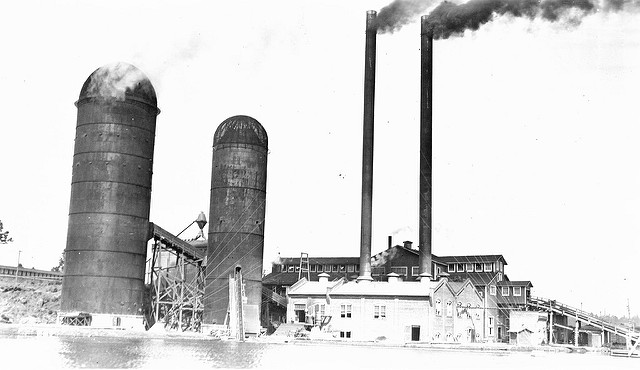The history of logging in Central Oregon might as well be a history of Bend! Heard of the Old Mill District? As the name implies, it was originally a sawmill, one of the biggest in the world at the time. How about Drake Park? Today it’s one of our favorite green spaces along the Deschutes River. It’s named after Alexander Drake, the entrepreneur behind the first lumber mill in Bend.
The Early Days
Okay, we weren’t completely truthful above; a history of Bend’s really early days would be mostly about ranching. But after the ranchers were established, there were a few forward-thinkers who secretly realized that the vast virgin forests of central Oregon held riches within. With the supply of jack pines and Douglas-firs from the Great Lakes and the western Cascades regions almost completely depleted, there was a need for new reservoirs of lumber. The eastern Cascades would be one of them.
These pioneers also realized that, without railroads extending into central Oregon, they wouldn’t be able to do anything with the lumber after they cut it! So, instead of developing mills and hiring workers, they waited patiently and acquired hundreds of thousands of acres of timberland. Much of that land, acquired through a legal loophole, would later be returned to the federal government and incorporated into our beloved backyard: the Deschutes National Forest.
The turn of the century saw Alexander Drake, a middle-aged businessman, pick up and move his family from Minnesota to Oregon – in a covered wagon, no less. Must have been a pretty severe midlife crisis! Upon arrival, he immediately formed the Pilot Butte Development Company, which built irrigation canals (some of which are still in use), buildings, and – you guessed it – Bend’s first commercial sawmill. The Columbia Southern railroad ended over 80 miles away, so the Pilot Butte Company still dealt with the challenge of exporting the logs they cut. With all this development, the city of Bend was incorporated in 1904.
Image courtesy of OSU Special Collections
The Boom Years
In 1916, just a few years after the railroad finally reached the tiny town of Bend, two corporations from Minnesota followed in Drake’s footsteps and opened up two of the largest mills in the world – one just months after the other – on the banks of the Deschutes River just south of downtown. Bend’s population ballooned from 500 to 5,000 in just a few years, a growth attributable almost entirely to lumber.
Logging eventually came to Prineville, Chemult, Sisters, and other towns in central Oregon, but the largest production by far came from the areas around Bend. That’s where the mills were! Smaller mills supplemented the two behemoths because the forests around Bend were perfect for logging. Our native ponderosa pines were straight, tall, and so open that you could drive a Model T through the forest without a road. Still, you can’t carry lumber on a Model T. Rail was the way to go. By 1930, logging railroads ribboned in every direction from Bend. Lumberjacks, leaving clear-cuts in their wake, moved to where the trees were, and their houses, built to be portable by rail with lightweight materials and foldable porches, went with them. The Deschutes River, which the mills used as a retaining pond, became choked with logs.
Such rabid production could not last. By the late 1940s, the environmental realities of so much clearcutting began to catch up with the mills. At peak production, the 500 million board feet sawed per year by the big mills in Bend had been over six times what the forests in the area could sustainably support. The Shevlin-Hixon mill sawed its last log in 1950.
Transition
Brooks-Scanlon, Bend’s other mill, absorbed Shevlin-Hixon’s operations and continued cutting away until the early 1990s. By then, timber harvests had declined significantly, and almost all the other mills had closed as well. Only one mill currently remains in central Oregon, about 50 miles south of Bend in the former company town of Gilchrist. And, though there are no mills here anymore to process the timber, there is still logging in the Bend area as well. The legacy of our industrious beginnings lives on.
The Old Mill today.
It is because of logging that…
Many Forest Service roads, having been built on the old logging railroad grades, exist where they are.
- Scandinavian millworkers first came to the Cascades, bringing sports like alpine skiing with them.
- The iconic smokestacks of Bend’s Old Mill District exist; they are the original smokestacks from the powerhouse of Brooks-Scanlon’s Mill B. Today they adorn and give historical context to REI.
So in the Central Oregon A-to-Zs, how could L not be for logging! We could go on and on about the operations of the mills in Bend, or the groundbreaking legislation that opened the American West, or how logging and fire interrelate on our National Forest land.
Come on a tour with us and learn more!
Guest post by Naturalist Guide Danny! Check out his adventure blog here.
Sources:









